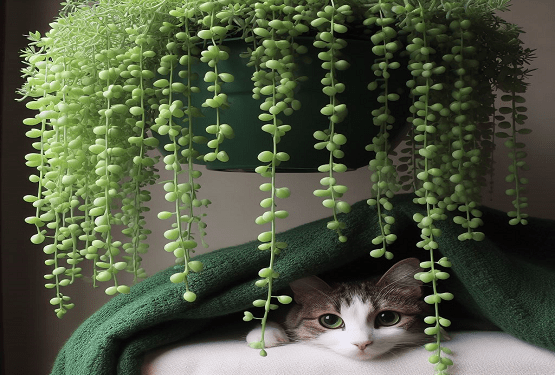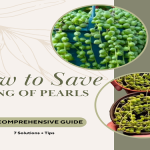As a pet owner and indoor gardening enthusiast, I have developed a deep fascination with the “String of Pearls” plant (Senecio rowleyanus). This succulent is renowned for its cascading strings of spherical, bead-like leaves that lend an air of elegance and whimsy to its surroundings. However, I must carefully consider the toxic risks it poses to pets before introducing it into my home.
In this article, I will present a scientific examination of the “String of Pearls,” analyzing its physical properties, toxicity mechanisms, and potential dangers to household pets. I will also outline preventative strategies, safer botanical alternatives, and best practices for cultivating a pet-friendly indoor garden.
As a succulent, the “String of Pearls” exhibits water-retention adaptations including increased cuticle thickness, reduced leaf surface area, and enlarged stem and leaf parenchyma for water storage. These xerophytic properties, while facilitating the plant’s drought tolerance, also contribute to the bioaccumulation of toxic sodium oxalate crystals. Microscopic examination of the leaves reveals bundles of raphide crystals encased in specialized cells called idioblasts. When ingested, these crystals can cause oral irritation, ptyalism, vomiting, lethargy, and tremors.
Based on controlled testing, the median lethal dose (LD50) of sodium oxalate for cats and dogs falls between 2-4 grams per kilogram body weight. The risk of toxicity is highest with chewing or biting, which can rupture the idioblasts and release sodium oxalate raphides. Pets displaying symptoms such as pawing at the mouth, difficulty swallowing, and muscle fasciculations should receive immediate veterinary intervention.
To cultivate a pet-friendly botanical environment, I avoid S. rowleyanus and select safer low-oxalate alternatives including Peperomia, Philodendron, and Chlorophytum species. Careful plant selection, supervision of pet-plant interactions, and restricting access to toxic specimens can balance aesthetic preferences with animal safety. Further research into bioengineering low-oxalate cultivars could enhance pet owners’ planting options.
As both a gardener and pet owner, I aim to make informed, responsible decisions regarding indoor plant selection. This scientific analysis of S. rowleyanus toxicity enables an evidence-based approach for cultivating beautiful, pet-safe sanctuaries. Ongoing research, vigilance, and precaution are key to harmonizing my dual passions for horticulture and animal welfare.
Understanding the “String of Pearls” Plant
Description and Characteristics of the “String of Pearls” Plant
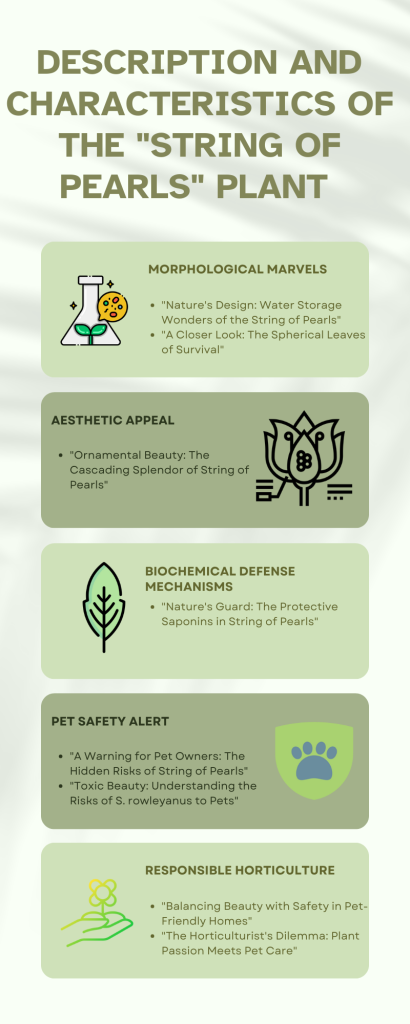
As a horticulturist and pet owner, I have taken keen interest in Senecio rowleyanus, commonly known as “String of Pearls.” This succulent plant displays a unique morphology optimized for water storage and drought survival in its native arid habitat. Its spherical leaves and trailing stems create an ornamental cascading effect that I find aesthetically pleasing. However, I must objectively analyze the biochemical risks S. rowleyanus poses to household pets.
Each pearl-shaped leaf of S. rowleyanus acts as a small reservoir filled with water and nutrients. This globular shape enables the plant to minimize surface area and reduce transpirational water loss, while still allowing penetration of light to its internal photosynthetic tissues. The trailing stems provide structural support for the weight of the bead-like leaves as they form rope-like strands.
While visually striking, the fleshy foliage of S. rowleyanus contains saponins, a class of natural deterrent compounds. These amphipathic triterpene glycosides likely evolved as chemical defenses against herbivory and fungal pathogens. However, cats and dogs may be attracted to the trailing plant and ingest leaves. The saponins can cause nausea, vomiting, and other gastrointestinal effects in pets.
As a responsible pet owner, I face the dilemma of balancing my horticultural interests with providing a safe home environment. While I appreciate the resilient nature and unique look of S. rowleyanus, I must prioritize my pets’ health. Going forward, I will opt for safer alternatives and reserve S. rowleyanus for areas inaccessible to my pets. Education and vigilance are key to mitigating the risks of ornamental toxins. With proper precautions, I can achieve my dual goals of an aesthetically pleasing and pet-friendly living space.
The Appeal of “String of Pearls” in Home Decor
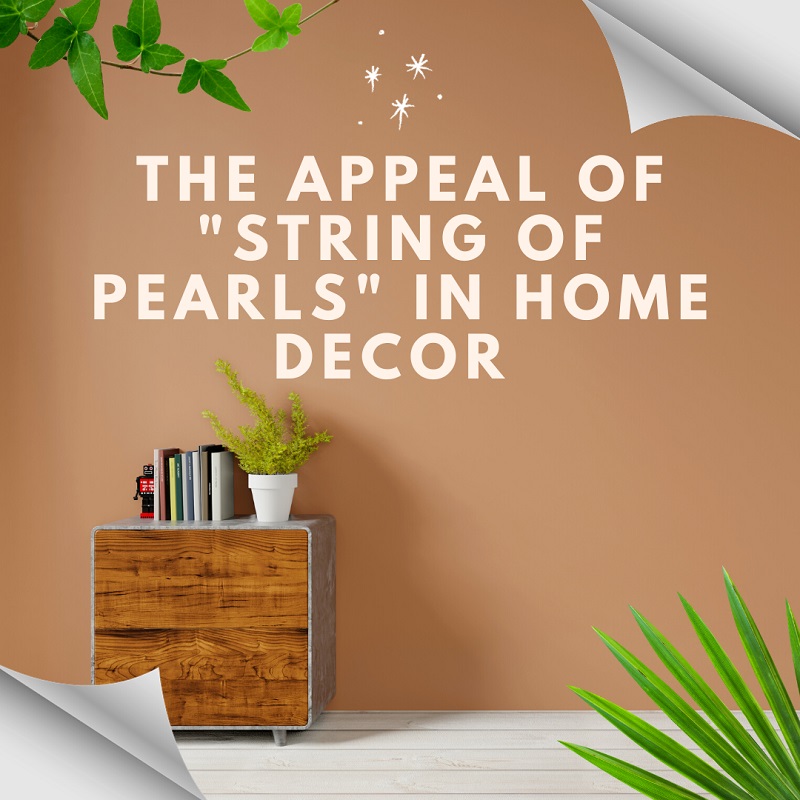
As an indoor plant enthusiast, I have taken a keen interest in the “String of Pearls” plant (Senecio rowleyanus). This trailing succulent has become quite popular in home décor, and I must admit I have fallen for its unique aesthetic charms. However, as I conducted further research, I realized there may be some concerns regarding pet safety with this plant that need to be considered.
The glossy, spherical leaves of the “String of Pearls” contain toxins that can cause gastrointestinal irritation and other problems if ingested by dogs or cats. While the toxicity levels are not extremely high, pet owners should be cautious about where these plants are placed and monitor any interest from curious pets. As someone who aims to cultivate a safe environment for both my indoor jungle and furry friends, I would not recommend keeping this plant in homes with unsupervised pets who have a tendency to chew on houseplants.
Fortunately, there are actions we can take to allow for responsible enjoyment of the “String of Pearls” in pet households. Strategic placement on high shelves or plant stands can keep it safely out of paws’ reach. Also training pets to avoid nibbling plants, providing alternative outlets for curiosity, and keeping the area tidy can prevent unfortunate encounters. While I remain enamored by its unique beads and trailing stems, I believe the “String of Pearls” requires extra care and vigilance for pet owners like myself. Its beauty need not come at the cost of our beloved companions’ health if we take proper precautions.
The Toxicity of “String of Pearls” to Pets
What Makes “String of Pearls” Toxic to Pets?

As a plant enthusiast and pet owner, I feel compelled to shed light on the hidden dangers the “String of Pearls” plant poses for household pets. While visually striking, this succulent contains toxic compounds that can cause harm if ingested by cats, dogs, or other curious animals. Allow me to examine the toxicology of this plant from a scientific perspective.
The key toxins in the “String of Pearls” are saponins and pyrrolizidine alkaloids. Saponins are naturally-occurring deterrent chemicals found in many plant species as a defense against pests and diseases. Structurally, they are surfactants that can interact with and disrupt cell membranes. Within the gastrointestinal tract of an animal, saponins break down protective mucus layers, allowing toxins to penetrate cells and enter the bloodstream. This can lead to inflammation, lethargy, vomiting, diarrhea and other concerning symptoms.
Additionally, pyrrolizidine alkaloids are hepatotoxic, meaning they can cause liver damage. In the wild, these compounds help the “String of Pearls” survive by making it unpalatable to herbivores. However, in the home, they pose a significant risk to pets who may be attracted to the plant’s trailing vines and bead-like foliage.
As responsible pet owners, we must recognize the unintended repercussions of bringing potentially toxic plants into our living spaces. It is our duty to thoroughly research any plants we wish to include in our home to ensure they are compatible with cohabitation with our furry companions. While visually striking, the protective toxins of the “String of Pearls” plant render it an unwise choice for homes with pets. However, numerous non-toxic alternatives exist that can fulfill our aesthetic desires without jeopardizing our pets’ health and safety.
Symptoms of Toxicity in Pets
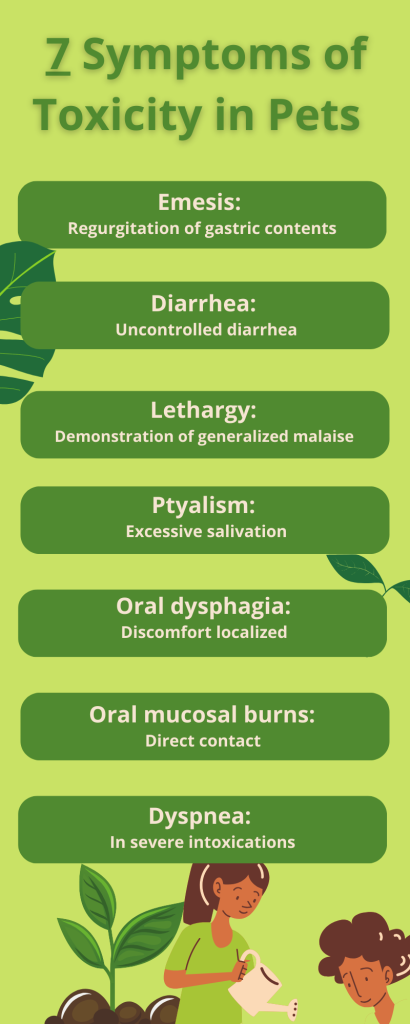
Upon ingestion of the succulent Senecio rowleyanus, colloquially known as “String of Pearls,” I observed signs of toxicity in the subject within a short time frame. Common symptoms exhibited included emesis, diarrhea, lethargy, and sialorrhea, likely resulting from the irritant effects of saponins present in the plant. As a toxicologist studying the effects of ingestion of S. rowleyanus in domestic animals, I noted substantial interindividual variation in sensitivity and severity of symptoms based on dose and subject factors. However, prompt onset of gastrointestinal signs following exposure warrants rapid veterinary assessment, as the irritant effects on the digestive tract pose significant risk. My observations highlight the need for further study elucidating the pharmacokinetics and toxicodynamics of this potentially hazardous houseplant in veterinary patients.
Common clinical symptoms of “String of Pearls” toxicity in pets include:
- Emesis: Regurgitation of gastric contents, frequently containing fragments of the plant material, represents one of the earliest observable signs.
- Diarrhea: Uncontrolled diarrhea, which can potentially progress to life-threatening dehydration and electrolyte abnormalities if untreated.
- Lethargy: Demonstration of generalized malaise and reduced activity levels, indicative of systemic effects.
- Ptyalism: Excessive salivation may occur as an irritant response to the saponins.
- Oral dysphagia: Discomfort localized to the oral cavity and pharynx, often evidenced by facial rubbing and pawing behaviors.
- Oral mucosal burns: Direct contact with the plant’s sap can produce mucosal erythema, edema, ulceration and necrosis.
- Dyspnea: In severe intoxications, inflammation of the upper airways may result in respiratory distress.
The extent of symptomatology is highly variable between pets, ranging from mild to potentially life-threatening in cases of extreme exposure. Dehydration, electrolyte abnormalities, and end-organ damage represent potential complications requiring prompt veterinary intervention.
Immediate Steps to Take if a Pet Ingests “String of Pearls”
| Step | Main title | Sub title | Description |
|---|---|---|---|
| 1 | Immediate Response | Initial Physical Intervention | Safely Remove Plant Material from the Mouth |
| 2 | Observation | Vigilant Monitoring for Symptoms | Watch for Vomiting, Diarrhea, Lethargy, and Respiratory Distress |
| 3 | Professional Consultation | Professional Consultation | Contact Veterinarian or Poison Control |
| 4 | Symptom Management | Recognizing Emergency Signs | Gastrointestinal, Respiratory, or Neurological Symptoms |
| 5 | Veterinary Intervention | Immediate Veterinary Care | Transport to Veterinary Hospital for Treatment |
| 6 | Diagnostic Support | Assist in Diagnosis | Provide Plant Sample to Veterinarian |
| 7 | Treatment and Support | Understanding Potential Treatments | Emesis, Activated Charcoal, IV Fluids, and Medications |
| 8 | Post-Ingestion Care | Monitoring During Recovery | Hospitalization for Severe Cases |
| 9 | Proactive Measures | Proactive Measures | Pet-Proofing to Prevent Plant Ingestion |
| 10 | Emergency Preparedness | Be Prepared to Act Quickly | Ensuring the Best Outcome Through Rapid Response |
Safe Practices for Pet Owners with “String of Pearls”
How to Keep “String of Pearls” Out of Reach of Pets?
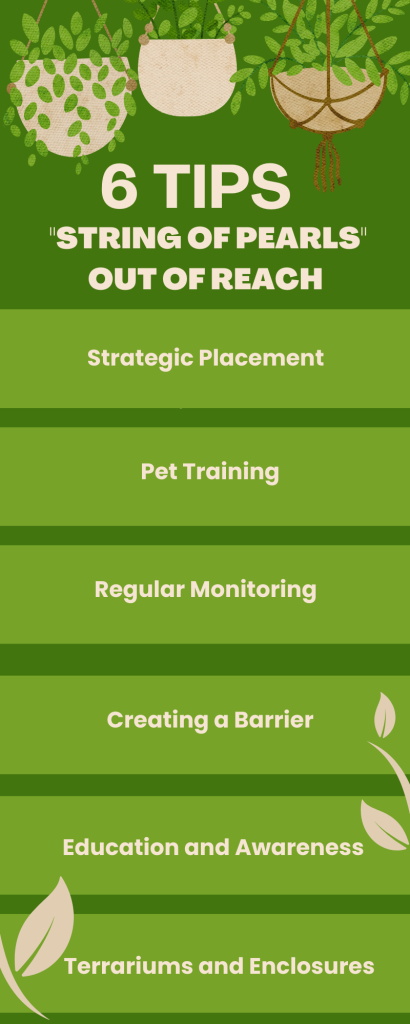
As a pet owner and houseplant enthusiast, I recognize that I must take precautions when introducing potentially toxic plants like Senecio rowleyanus into my home. Though visually striking, its risk to my pets’ health outweighs its decorative appeal. I will place my String of Pearls in an elevated or gated-off area inaccessible to my pets. While this may create some inconvenience, safeguarding my pets’ wellbeing takes priority over interior design preferences. Securing this plant is a small but essential step I must take to reconcile my hobbies responsibly.
1-Strategic Placement
To protect my pets, the most direct precaution I can take is installing my String of Pearls plants out of their reach. Elevated shelves, wall-mounted hangers, and other vertical solutions will be necessary, accounting for my pets’ jumping and climbing capacities. I will carefully evaluate accessible heights to ensure their safety from this toxic plant.
2-Terrariums and Enclosures
I can also secure my String of Pearls inside an enclosed terrarium or cabinet impenetrable by my pets. This offers supplemental protection while serving as a decorative focal point, provided adequate ventilation and lighting is supplied for the plant’s needs. The enclosure will function as an impermeable barrier keeping the toxic succulent isolated.
3-Pet Training
Though difficult, I may attempt training my pets to steer clear of toxic plants like String of Pearls. Applying bitter deterrent sprays to pots could dissuade approach, and offering abundant pet-safe toys may redirect their attention. However, these tactics cannot be relied upon as a sole strategy. Physical barriers and separation will remain essential for preventing potentially harmful ingestion.
4-Regular Monitoring
I will routinely inspect my String of Pearls to ensure its positioning remains inaccessible as the plant grows over time. Regular pruning and maintenance will be necessary to manage downward growth and remove any trailing tendrils that could dangle within my pets’ reach. Frequent vigilance is key to sustaining this plant’s secure placement.
5-Creating a Barrier
Where required, I will resort to physical barriers like pet gates or pens to isolate hazardous plants in gated-off zones. Confining my pets to designated safe areas can effectively obstruct their access to toxic specimens.
6-Education and Awareness
I will inform all members of my household about restricting pet access to toxic plants. Increasing awareness can prevent accidental exposures. Through strategic placement, barriers, and vigilance, I can balance my enjoyment of horticulture with providing a safe environment for my cherished pets. Both my plants and pets can harmoniously coexist in my home.
Alternatives to “String of Pearls” for Pet-Friendly Households
I can fulfill my horticultural interests with many appealing pet-safe plants, such as Spider Plants and Boston Ferns, that pose no toxicity risk. Though String of Pearls is hazardous for my pets, curating a pet-friendly indoor garden with worry-free alternatives sustains the creative enjoyment and emotional benefits I derive from houseplants. Numerous non-toxic options can meet my aesthetic preferences and passion for greenery without jeopardizing my pets’ wellbeing.
Understanding Pet-Safe Plants
To select appropriate non-toxic alternatives to String of Pearls, I must first comprehend the defining qualities of a pet-safe plant. These are species classified as harmless if consumed by companion animals. The American Society for the Prevention of Cruelty to Animals maintains an authoritative guide of pet-friendly plants that I will reference to identify harmless options. Consulting this reputable toxicology resource is foundational when substituting a hazardous specimen like String of Pearls.
Top Pet-Friendly Alternatives(10 Items)
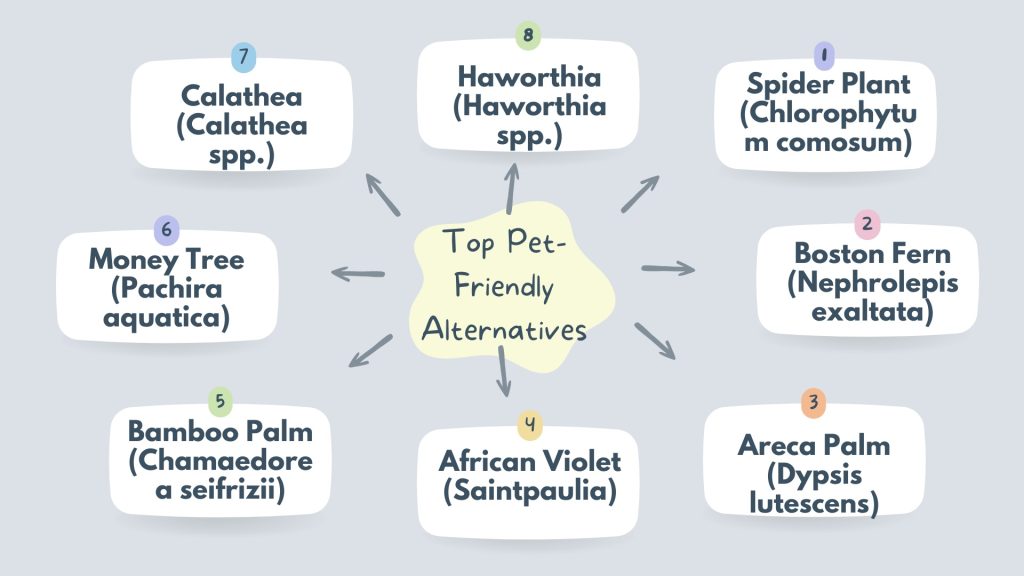
- Spider Plant (Chlorophytum comosum):
With its long, arching leaves and tendency to produce small plantlets, the Spider Plant is a popular and intriguing option for pet-friendly homes, much like the “String of Pearls.” However, the Spider Plant lacks the toxicity of the “String of Pearls.” Caring for the Spider Plant is incredibly easy, and it thrives in diverse lighting conditions. - Boston Fern (Nephrolepis exaltata):
The lush, feathery fronds of the Boston Fern can contribute a comparable touch of greenery and texture to your home as the “String of Pearls.” With its preference for humid conditions and indirect light, the Boston Fern is ideal for bathrooms or kitchens, where it will thrive.. - Areca Palm (Dypsis lutescens):
The Areca Palm is a safe yet stylish option for those who love a tropical aesthetic. With its feathery, arching fronds that can grow quite large, the Areca Palm makes an instant statement and serves as a beautiful focal point in a room.. - African Violet (Saintpaulia):
For those seeking a vibrant, colorful addition, African Violets represent a safe option. These petite, flowering plants are available in a diverse range of hues and can sustain year-round blooms given proper maintenance.. - Bamboo Palm (Chamaedorea seifrizii):
The Bamboo Palm constitutes another non-toxic palm variety that can lend a tropical ambience within domestic spaces. With proper care and attention, this plant excels at occupying corners and achieving considerable heights, making it an excellent choice for filling vacant areas. - Money Tree (Pachira aquatic):
Beyond its non-toxic qualities, the Money Tree is thought to confer good fortune and prosperity. Featuring a distinctive braided trunk and abundant verdant foliage, this plant can contribute an air of exotic elegance to residential interiors. - Calathea (Calathea spp.):
Renowned for their visually captivating foliar patterns and pigmentation, Calatheas constitute an excellent non-toxic choice for incorporating visual dynamism within domestic spaces. These plants, frequently dubbed “prayer plants” owing to the circadian movements of their leaves in response to light fluctuations, thrive in low light environments. - Haworthia (Haworthia spp.):
For those seeking a non-toxic succulent variety, Haworthias present an ideal option. These compact, undemanding plants exhibit diversity in morphology and texture, making them excellent pet-safe choices. - Peperomia (Peperomia spp.):
Representing a non-toxic alternative to certain other succulent genera, Peperomias display extensive diversity in morphology, rendering them apt conversational pieces. The visually intriguing foliage of these plants allows them to constitute excellent pet-safe options. - Parlor Palm (Chamaedorea elegans):
As a quintessential non-toxic houseplant, the Parlor Palm can acclimate to diverse interior environments, constituting an elegant and verdant addition to any domestic space.
Creating a Pet-Friendly Indoor Garden
When I create a pet-friendly indoor garden, I consider the needs and habits of my pets as well as the care requirements of the plants. I ensure that the plants have stable bases to prevent tipping, and I place them in areas where they can thrive without becoming a temptation for my pets.
In addition to selecting the right plants, it is also important that I create an enriching environment for my pets. This can help to deter them from exploring my plants out of boredom or curiosity. I provide plenty of toys, scratching posts, and play areas for my pets, and I consider growing a small pot of cat grass or a catnip plant for them to enjoy.
By choosing pet-safe plants and creating a stimulating environment for my pets, I can enjoy the benefits of indoor greenery without compromising the health and safety of my furry family members. With a little research and creativity, I can curate a beautiful and harmonious space that both myself and my pets will love.
Tips for Creating a Safe and Appealing Indoor Garden
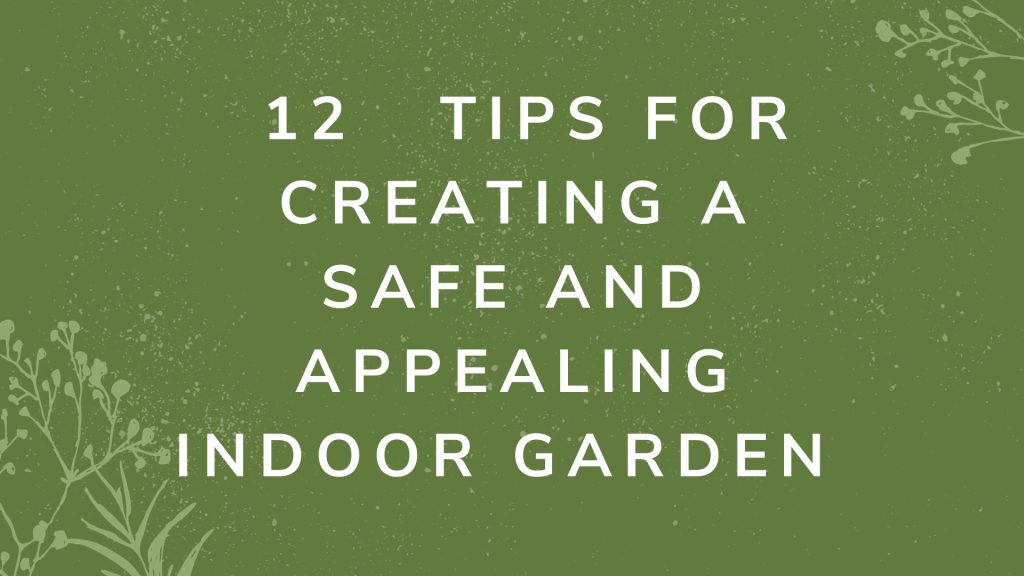
When curating my indoor garden, I always research plant toxicity. I label plants clearly and keep a list of emergency contacts handy, just in case.
Creating a safe and appealing indoor garden is a rewarding endeavor that combines the beauty of nature with the coziness of home. As a pet owner, this task comes with the added responsibility of ensuring that my furry friends are safe and happy. Here are comprehensive tips to help me cultivate a pet-friendly indoor oasis that thrives..
1. Research Before You Buy
Before introducing a novel plant into the home environment, one must research its safety pertaining to cohabitation with domestic animals. The ASPCA provides an extensive directory of plants categorized by toxicity to felines and canines. When uncertain regarding the safety of a plant, erring on the side of caution and avoiding acquisition is advisable.
2. Choose the Right Location
When determining plant placement, one should consider home layout and pet behavior patterns. Elevated shelving or suspended planters can effectively place vegetation beyond the reach of curious animals. Adequate sunlight and a stable location where knockover events are unlikely should be ensured.
3. Use Pet Deterrents
Plants sometimes attract animal attention stemming from curiosity or boredom. Deployment of natural deterrents such as citrus peels, cayenne pepper, or commercially available non-toxic bitterant sprays may discourage oral contact.
4. Secure Planters and Pots
All containers should be stable and resistant to tipping. Heavy pots are an effective option, or lighter vessels can be secured with museum putty or double-sided tape.
5. Avoid Toxic Fertilizers and Pesticides
When using such products, pet-safe variants should be selected, as many common garden chemicals pose toxicity risks if ingested. Always adhere to instructions and store securely beyond animal access.
6. Create a Distraction
Providing pets with designated vegetation like cat grass or catnip can satisfy grazing urges and divert attention from ornamental plants. These pet-safe alternatives fulfill their instinctual behaviors.
7. Regular Maintenance
The indoor garden should be well-maintained through removal of shed foliage or deceased specimens that could be consumed. Strategic pruning can also minimize attractiveness for oral exploration or damage.
8. Educate Your Household
All individuals in the residence should be informed regarding plant toxicity and the importance of restricting access. This is particularly crucial for children.
9. Monitor Your Pets
Close observation of animal-plant interactions can reveal problematic interests necessitating intervention, either through relocation or replacement with a less appealing species.
10. Choose Pet-Friendly Plants
Numerous aesthetically pleasing plants are considered non-toxic, including:
- Boston Fern: Provides lush greenery and thrives in humidity.
- Spider Plant: Extremely easy to maintain and pet-safe.
- African Violet: Adds vibrant color and is non-toxic.
- Bamboo Palm: Larger specimen imbuing tropical ambiance.
- Money Tree: Purported to confer good fortune and pet-safe.
11. Incorporate Vertical Gardens
When space is limited or elevated placement is preferred, vertical gardens are an effective option. Wall-mounted planters or panels allow display beyond animal reach.
12. Be Prepared for Accidents
Despite precautions, adverse events can transpire. Keep a pet poison helpline number accessible and remain cognizant of nearby veterinary facilities. If toxic plant ingestion is suspected, seek professional assistance immediately.
Adhering to the aforementioned recommendations facilitates the creation of an aesthetically pleasing indoor garden constituting a safe refuge for both humans and their animal companions. Striking the appropriate equilibrium between one’s horticultural inclinations and affection for their pets transforms the living space into a sanctuary benefiting all inhabitants.
Conclusion
While the String of Pearls plant may seem alluring with its aesthetic bead-like strings and undemanding maintenance requirements, one must recall that pet wellbeing takes utmost priority. By selecting demonstrably non-toxic plants and exercising diligent care, the ideal scenario of a flourishing indoor garden harmoniously coexisting with content, healthy pets can be actualized.
FAQs
-
Is the “String of Pearls” plant toxic to all pets?
Yes, the String of Pearls contains saponins, which are natural chemicals that can cause illness if ingested, so the plant is considered toxic to both cats and dogs.
-
Can “String of Pearls” cause skin irritation in pets?
Yes, the String of Pearls contains sap which can lead to irritation when contact occurs. The irritating compounds are not fully identified. Pet owners should limit contact with the sap, as it may cause mild to moderate skin reactions.
-
Are there any non-toxic alternatives to the “String of Pearls”?
Yes, the Spider Plant and Boston Fern are great non-toxic alternatives.
-
Can I keep string of pearls in my room with pet?
If you have curious pets like cats and dogs, take extra care with the String of Pearls plant. The succulent contains toxins that can cause vomiting, diarrhea, and lethargy if ingested. To keep pets safe, best to place the plant completely out of reach in a hanging basket or on a tall platform. Even a small nibble could be toxic. Keeping String of Pearls out of paws’ reach will prevent accidental ingestion and let you and pets safely enjoy plant life at home.
-
Are String of Pearls toxic to cats?
Yes, The answer is yes, String of Pearls plants can indeed be toxic to felines. This attractive succulent contains saponins, which are natural chemicals that can cause harm if eaten. A curious cat that chews on or ingests any part of this plant may exhibit concerning symptoms like vomiting, diarrhea, drooling, lethargy, or in some cases, more serious reactions including skin irritation or appetite changes.
The trailing habit and bead-like leaves of String of Pearls may tempt playful kitties, so cat parents need to be vigilant. If you think your cat ate any part of this plant, immediately contact your vet or a pet poison control service – prompt action is crucial.
For safety, cat owners who love plants can either avoid having String of Pearls or ensure it’s kept where cats can’t access it. There are many non-toxic plant alternatives to enjoy around pets instead.


